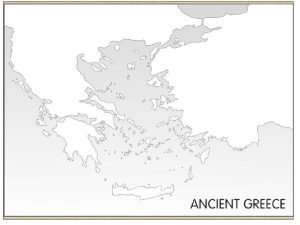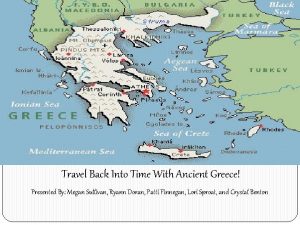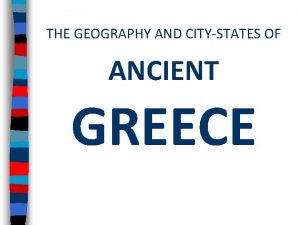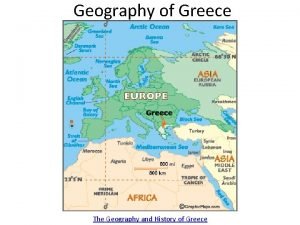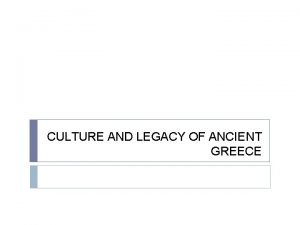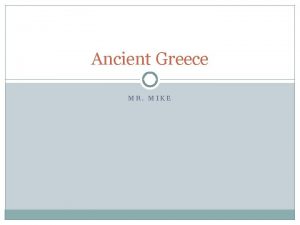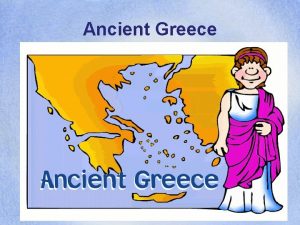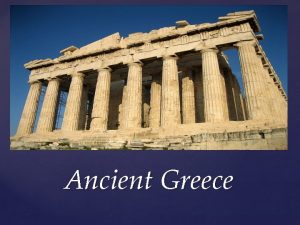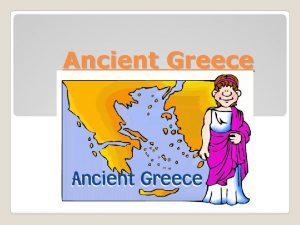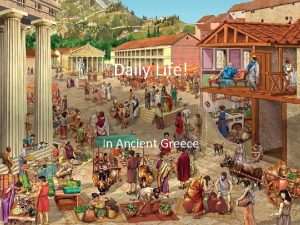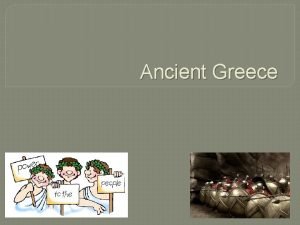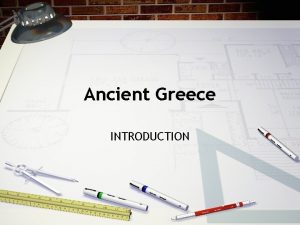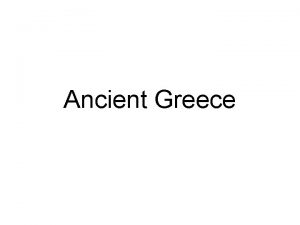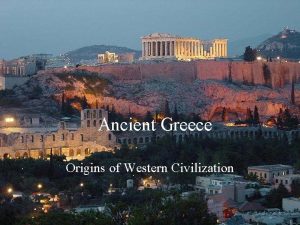Life in Ancient Greece Where was Ancient Greece
















- Slides: 16

Life in Ancient Greece

Where was Ancient Greece? • The Greeks called themselves 'Hellenes' and their land was 'Hellas'. The name ‘Greeks’ was given to the people of Greece later by the Romans. • They lived in mainland Greece and the Greek islands, but also in colonies scattered around the Mediterranean Sea. There were Greeks in what is now Italy, Sicily, Turkey, North Africa, and as far west as France.

Greek Historical Periods • In the years between 800 -700 BC, the Greeks started trading more with the outside world, they held the first Olympic Games and they fought off the invading Persian army. This period is known by historians as the ‘Archaic' period of Greek history. During this time many of the cities in Greece were ruled by a king-like figure. • Around 480 BC Greece entered a golden age which lasted for 200 years. The people built fantastic temples, made scientific discoveries, wrote plays and founded the first proper democracy. Historians call this ‘Classical Greece’. • The final period of Greek history is known as the ‘Hellenistic' period. This lasted from 323 BC to 30 BC, when the Romans took control of Greece. The Romans didn't destroy Greek life, though. They respected the Greeks and copied many things about their culture, including their buildings, beliefs and clothes.

How Was Ancient Greece Governed? Alexander the Great founded over 70 cities and created an empire that stretched across three continents, covering 2 million square miles. • There was never one country called ‘ancient Greece’. Instead, Greece was divided up into small 'city-states’, like Athens, Sparta, Corinth and Olympia. • Each city-state ruled itself. They had their own governments, laws and army. So, ancient Greeks living in Sparta considered themselves Spartan first, and Greek second. • Famously, the city-states didn’t get on very well and often fought each another. However, sometimes they joined together to fight against a bigger enemy, like the Persian Empire. • Only a very powerful ruler could control all Greece. One man did in the 300 s BC. He was Alexander the Great, from Macedonia. Alexander led his army to conquer an empire that stretched as far as Afghanistan and India

Ancient Greece had a warm, dry climate, as Greece does today.

Daily Life in Ancient Greece • Most people lived by farming, fishing and trade. Others were soldiers, scholars, scientists and artists. • Most people lived in villages or in the countryside. • Many Greeks were poor and life was hard, because farmland, water and timber for building were scarce. That's why many Greeks sailed off to find new lands to settle.

Homes in Ancient Greece • Ancient Greek homes were built around a courtyard or garden. The walls were often made from wood and mud bricks. They had small windows with no glass, but wooden shutters to keep out the hot sun. • They didn't have much furniture inside. People sat on wooden chairs or stools. Rich people decorated the walls and floors with colorful tiles and paintings. • Many homes didn’t have a bathroom. There were public baths, but most people washed using a small bucket or in a nearby stream. Only rich women (with slaves to carry the water) enjoyed baths at home. Afterwards they rubbed their bodies with perfumed oil to keep their skin soft. • At night, Greeks slept on beds stuffed with wool, feathers or dry grass. Most people went to bed as soon as it got dark. The only light came from flickering oil lamps and candles.

Ancient Greek Cities • Greek cities had beautiful temples with stone columns and statues, and openair theatres where people sat to watch plays.

What did they eat? This jar shows people harvesting olives. The olive is a very valuable tree in Greece. People ate the fruit, but also crushed olives to make olive oil. They used this for cooking, in oil lamps and cosmetics. • Men and women usually ate separately in ancient Greece. Rich people always ate at home - only slaves and poor people would eat in public. Everyone ate with their fingers, so food was cut up in the kitchen first. • So what was on the menu in ancient Greece? For breakfast, Greeks might eat fruit with bread dipped in wine. Lunch might be bread and cheese. • For dinner, people ate porridge made from barley, with cheese, fish, vegetables, eggs and fruit. For pudding people ate nuts, figs and cakes sweetened with honey. • Only rich people ate a lot of meat. They would eat hares, deer and wild boar killed by hunters. Octopus was a favorite seafood.

Men in Ancient Greece • Ancient Greece was a man's world. Men were in charge of the family and the home. A woman could not even leave the house without her husband's permission. • In wealthy homes, men were served food and entertained by slaves, while the women and children ate in another room. • Men wore long tunics. • Men would have to go out and earn a living. They could work in the army, politics, construction and trade, but most Greek men worked on farms growing and harvesting crops.

Women in Ancient Greece • Most Greek women didn't have a lot of freedom. • Married women had to stay at home. They spent their time spinning thread and weaving cloth. They also looked after the children and prepared food. • A Greek woman wore a long tunic called a ‘chiton’. This was made from a piece of cotton or linen. Over this, she wore a cloak draped from her shoulders, called a ‘himation’. This would be a thin material in summer and a thick one in winter. • Suntans weren't cool in ancient Greece, so women put white lead on their face to make their skin pale. White lead is poisonous, so it did more harm than good. • Rich women were only allowed to leave the house if they were accompanied by a slave or a male companion. Only poor women went out alone. They went shopping, fetched water and did the family washing in a stream.

Shoes & Jewelry • Many people walked around barefoot. Some wore leather sandals or, for horse-riding, high boots. • Both men and women wore wide-brimmed hats in hot weather, to shade their faces from the sun. • We know the Greeks liked jewelry too, because bracelets, earrings and necklaces are often buried with dead people in their tombs.

Girls in Ancient Greece • Most girls were between 13 and 16 years old when they married. Often their fathers chose husbands for them. • A girl's husband was usually older than she was, sometimes in his 30 s. • The day before she married, a girl sacrificed her toys to the goddess Artemis, to show she was now a grown-up. Girls might have played with small pottery figures and dolls made of rags. • Girls didn't go to school. They were taught housework and cooking at home by their mothers.

Boys in Ancient Greece • Many Greek parents wanted to have a son because they could look after them in old age. • Boys went to school at age seven. But teachers cost money, so poor boys didn't get much of an education. • Boys wore short tunics. • Most boys had to work hard as farmers, sailors, fishermen and craft workers. Children played with balls made from tied-up rags or a blown-up pig's bladder. The ankle-bones of sheep or goats were used in a game called 'knucklebones'.

Toys • Children played with small pottery figures, and dolls made of rags, wood, wax or clay some of these dolls even had moveable arms and legs. Other toys were rattles, hoops, yoyos and hobby horses (a ‘pretend horse’ made from a stick). • They also played with balls made from tied-up rags or a blown-up pig's bladder. A game of flicking nuts into a hole or circle may be the ancient Greek version of marbles or tiddlywinks! • Children also kept animals. There are pictures of children with pets, like dogs, geese and chickens. These girls are playing a game of 'knucklebones'. This was a bit like jacks, but played with the ankle-bones of goats or sheep.

Slaves in Ancient Greece • Owning slaves was considered a normal thing in ancient Greece, but only rich people could afford them. • Slaves could be men or women. Male slaves worked as gardeners and took care of the horses. Male slaves often wore just a strip of cloth called a loincloth. • Female slaves worked as nannies, cooks and cleaners. • Slaves who lived with rich families were treated well, so didn’t run away. But slaves who worked on farms, down mines or on trading ships were often treated badly.
 Map of greece with labels
Map of greece with labels Where was ancient greece located
Where was ancient greece located Ancient greece contributions
Ancient greece contributions Romans invade greece
Romans invade greece Physical
Physical Ancient greek legacies
Ancient greek legacies Aegean peninsula
Aegean peninsula Landforms in ancient greece
Landforms in ancient greece Ancient greece stations
Ancient greece stations The legacy of ancient greece chapter 31
The legacy of ancient greece chapter 31 Classic greek instrument
Classic greek instrument Values of greek drama
Values of greek drama On what continent is ancient greece located?
On what continent is ancient greece located? Ancient greece geography
Ancient greece geography Ancient greece map balkan peninsula crete
Ancient greece map balkan peninsula crete Why was cyrus considered a fair ruler
Why was cyrus considered a fair ruler Why did the tyrants fall out of favor
Why did the tyrants fall out of favor
